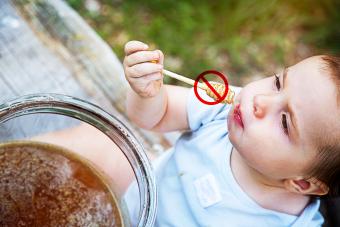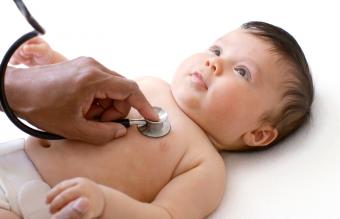
After you've chosen the bottles you want to use with your little one, it's important to make sure they are clean and germ-free. You may want to sterilize bottles when you first get them, after baby has been sick, or if you're using borrowed or used bottles. There are several ways to sanitize a bottle, but no matter which one you choose, the process is easy.
Old-Fashioned Boiling Method
This simple sanitization process is easy to accomplish before your baby arrives. It kills any germs that may be on the new bottles you got for your baby shower, and it gives you something to do with your nesting urges. You can also do this if you buy new bottles for an older baby.
Check the manufacturer's guidelines for heat. Glass bottles and some plastic options are designed to handle this level of heat, but some materials may not be.
- Fill your largest pot with at least enough water to cover the bottles if they are standing up.
- Before heating the water, place the bottles in it upside down. You'll need to put them in at an angle so you can get any air bubbles out of them. Drop in nipples as well.
- Bring the water to a boil and allow it to boil for 10 minutes.
- Remove the pot from the heat and let the water cool down before removing the bottles. Then wash and dry them as usual.
Dishwasher Sanitizing
If your bottles are dishwasher safe, you can skip the heavy pot and hot water and let the machine do the work for you. Always confirm bottles won't be damaged by the heat from your dishwasher before trying this method.
- Disassemble the bottle, removing rings, tops, nipples, and other parts.
- Place small parts in a dishwasher basket on the top rack. Put the bottles upside down where they won't clink together and crack.
- If your dishwasher has a sanitize cycle, add this to your normal wash. If not, turn your water heater up just for this cycle. Remember to turn it back down before baby arrives, since having very hot water can lead to accidental scalding at bath time. Make sure the dishwasher is set to heated drying.
- Run the cycle as usual. Remove the bottles when they are cool.
Sanitize in the Microwave
You can also use your microwave to steam sterilize your baby's bottles. You'll only be able to do a few at a time, and this process is for bottles only. You'll need to do the nipples a different way. Before sterilizing your bottles in the microwave, make sure the manufacturer says they are microwave safe.
- Place a paper towel on the turntable of your microwave to keep the bottles from slipping and to absorb any water that overflows.
- Fill each bottle part way with water, and place it upright on the microwave turntable. Do three or four bottles at a time.
- Set the microwave to high power and zap the bottles for two minutes. The water will boil and create steam inside the microwave.
- At the end of the cooking time, use an oven mitt to very carefully remove the bottles. Alternatively, wait for them to cool before you try to remove them.
- Wash and dry the bottles as usual.
To sterilize nipples and other parts that may touch baby's milk, you'll need to use a microwave sterilizing bag, such as the MaxStrength Premium Sterilizer Bags. These products, which sell for about one dollar apiece, seal the smaller parts in with some water to steam sterilize them.
Soak in a Weak Bleach Solution
Although the CDC recommends you throw away any severely contaminated bottles instead of sanitizing them, they suggest the following procedure for sanitizing with bleach.
Wear rubber gloves and an apron. Never mix bleach and ammonia and always work in a well-ventilated place.
- Wash and rinse bottles thoroughly.
- Mix one teaspoon of household bleach with one gallon of warm water.
- Soak the bottles and nipples for about two minutes.
- Remove the bottles and parts and rinse thoroughly. Wash and dry as usual.
Use a Dedicated Sterilizing Product
Many companies also make products designed specifically to sterilize baby bottles and pacifiers. Some, such as the Nuby One-Touch, also work as a bottle warmer. Reviews are mixed on these products, which sell for about $15 to $250, depending on features and sterilization method.
For Peace of Mind
Although doctors no longer consider it necessary that parents sterilize baby bottles, it's something many parents choose to do for peace of mind. No matter which process you choose, you shouldn't make it part of your regular cleaning. The Bump notes too-frequent sterilization can weaken the materials of the bottle and create unnecessary wear. However, there's enough to worry about with a new baby, and sanitizing the bottles when you first get them may take some of the stress out of this busy time.







